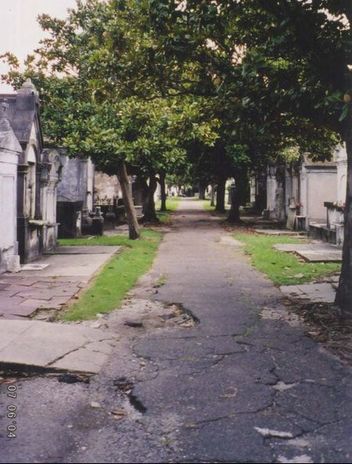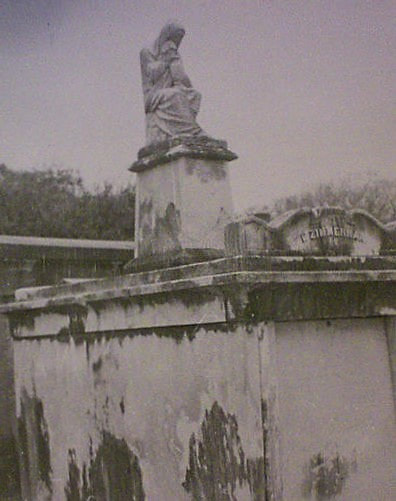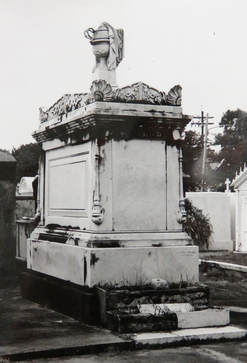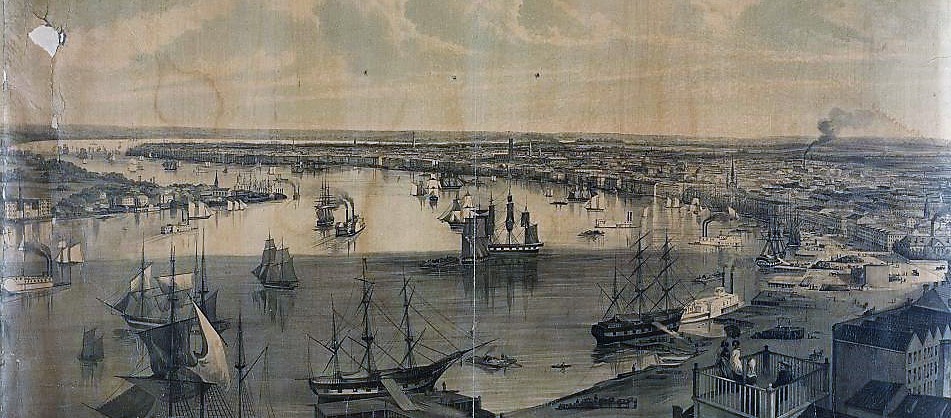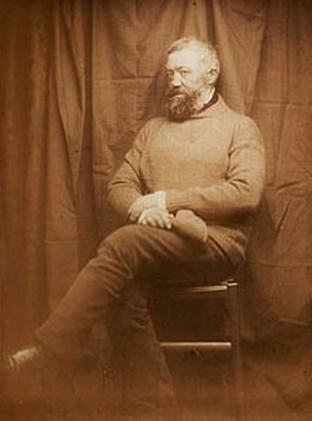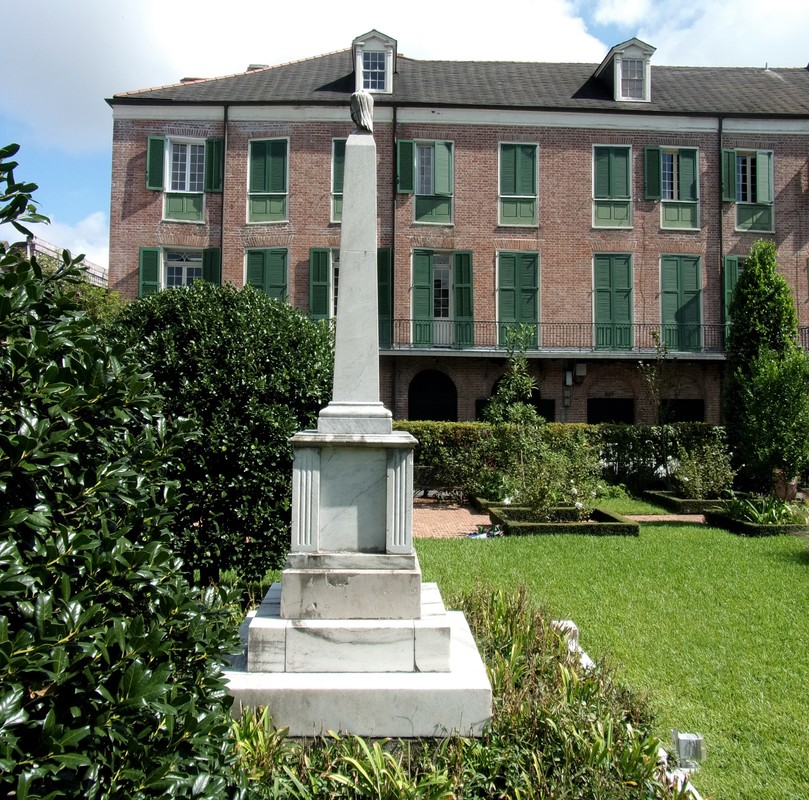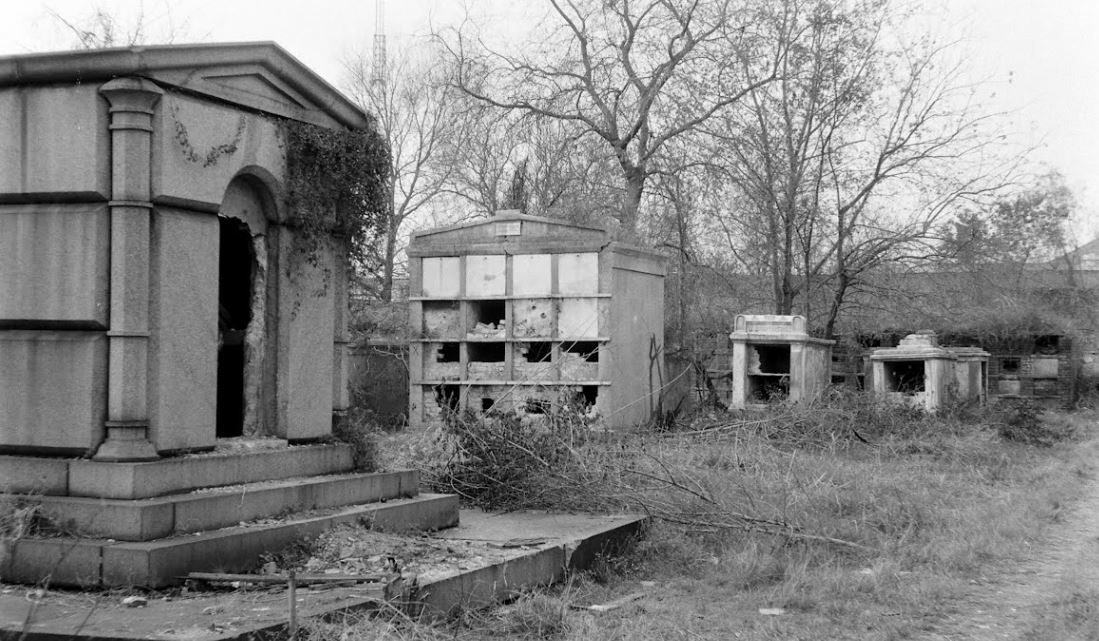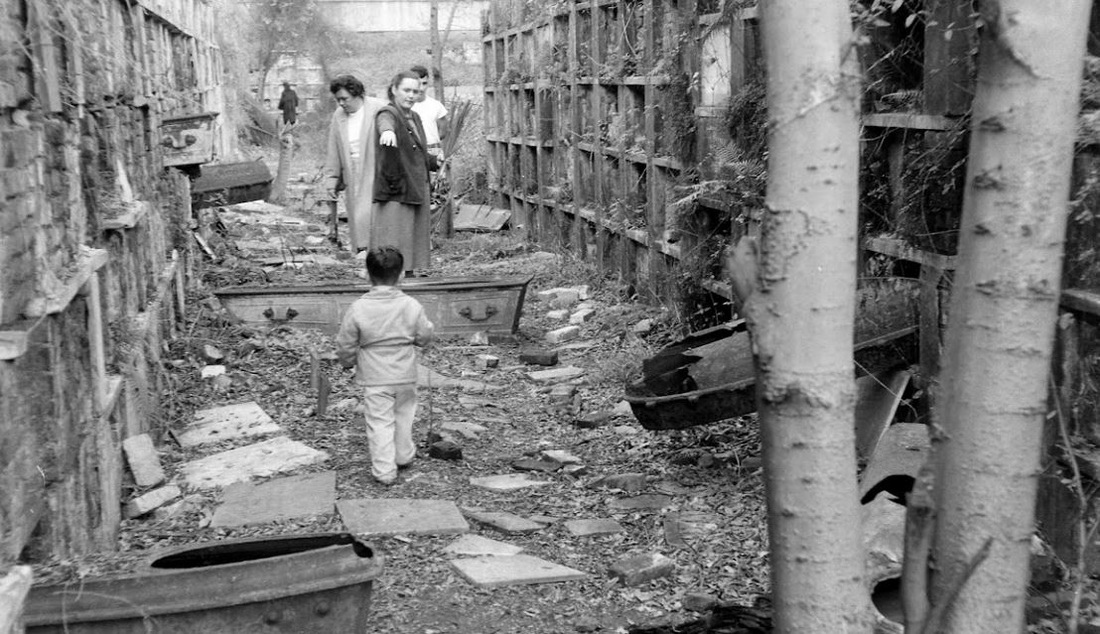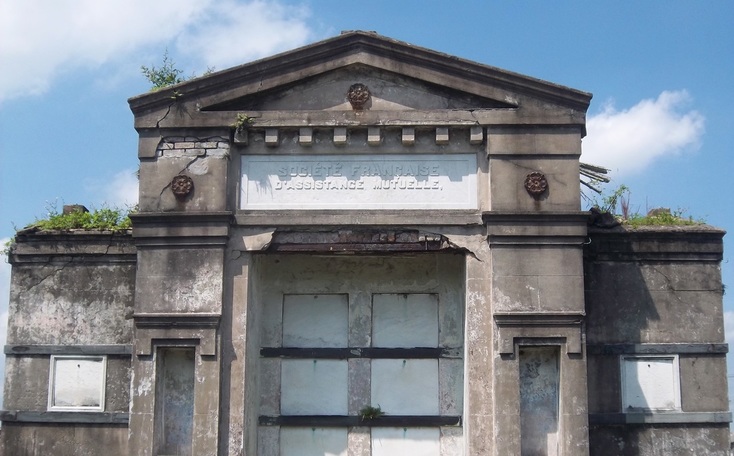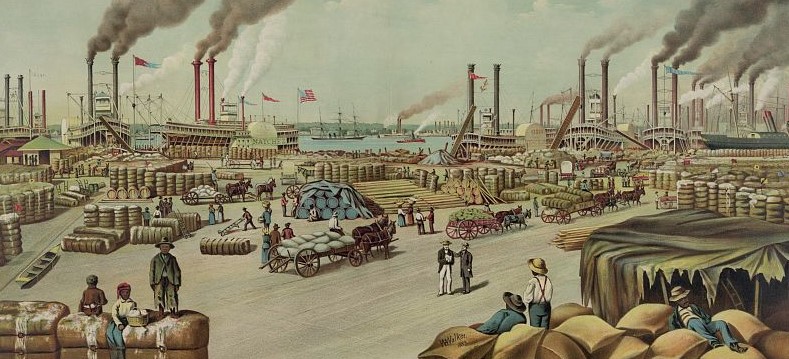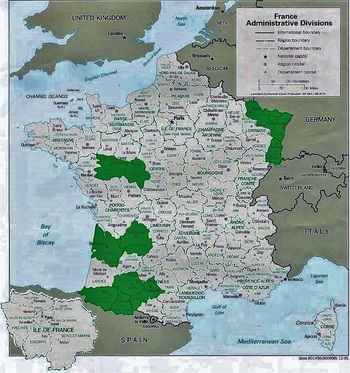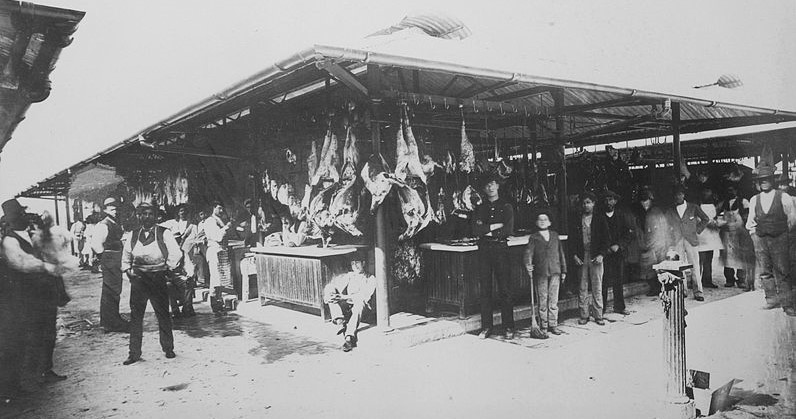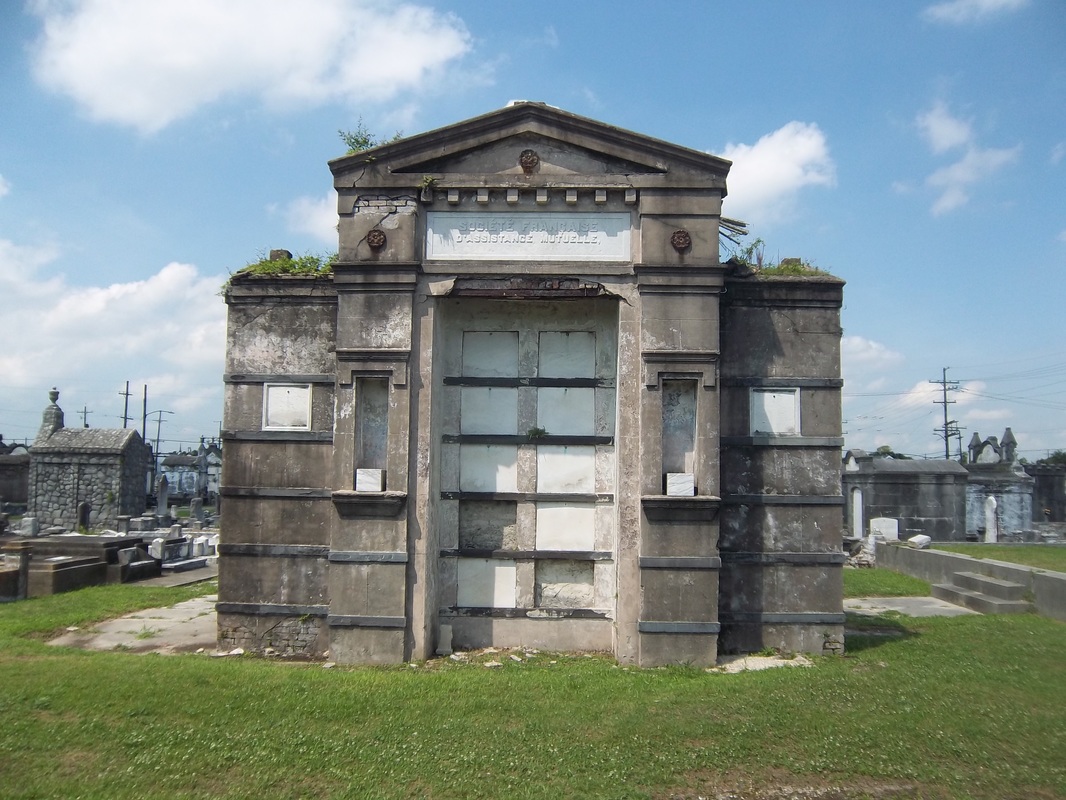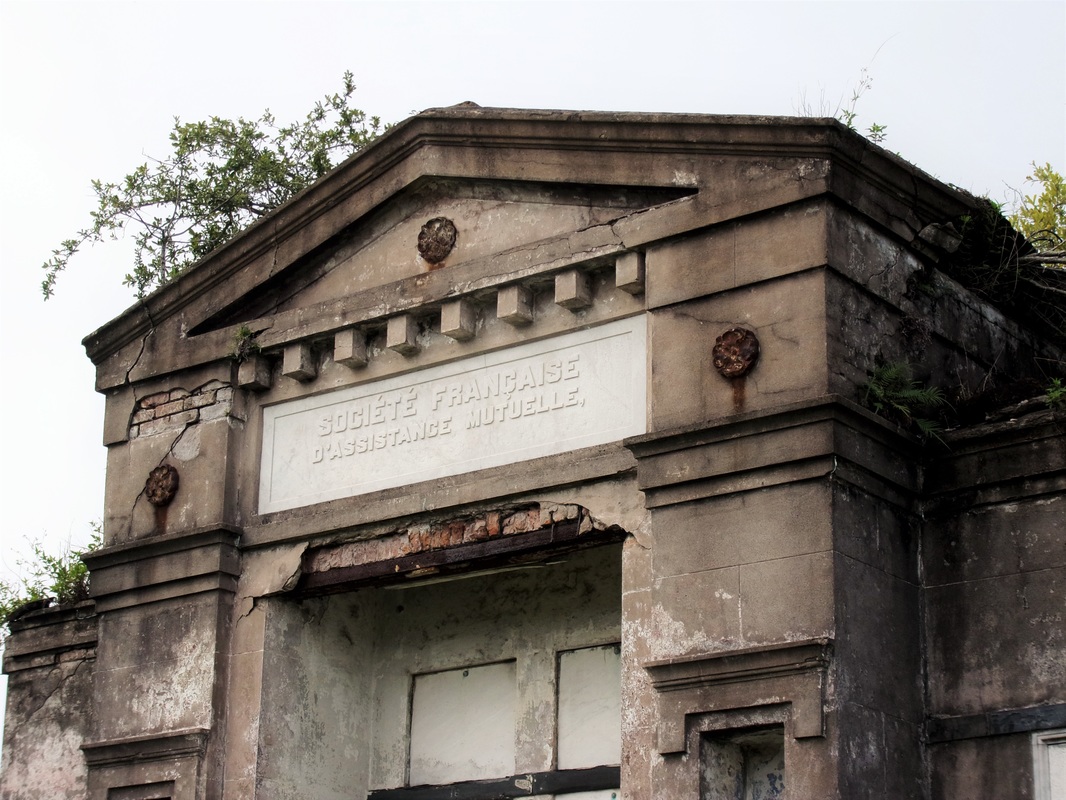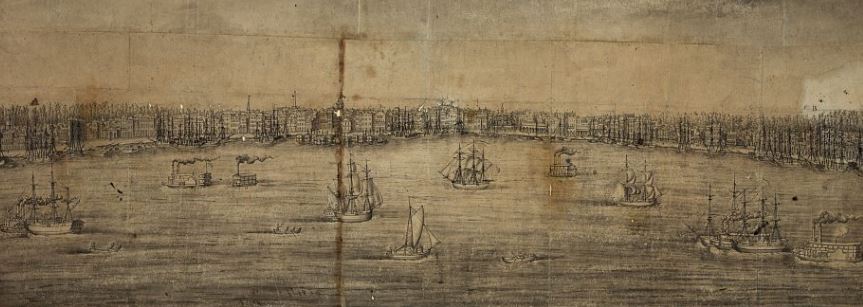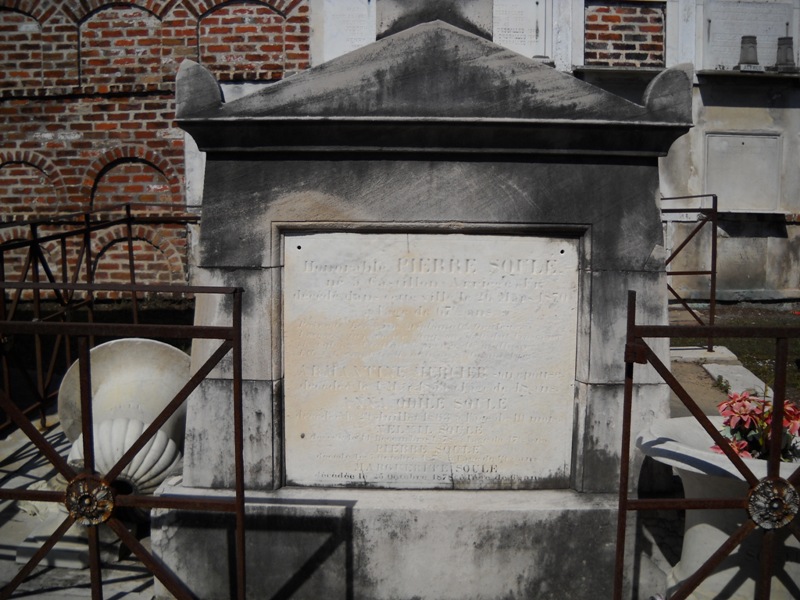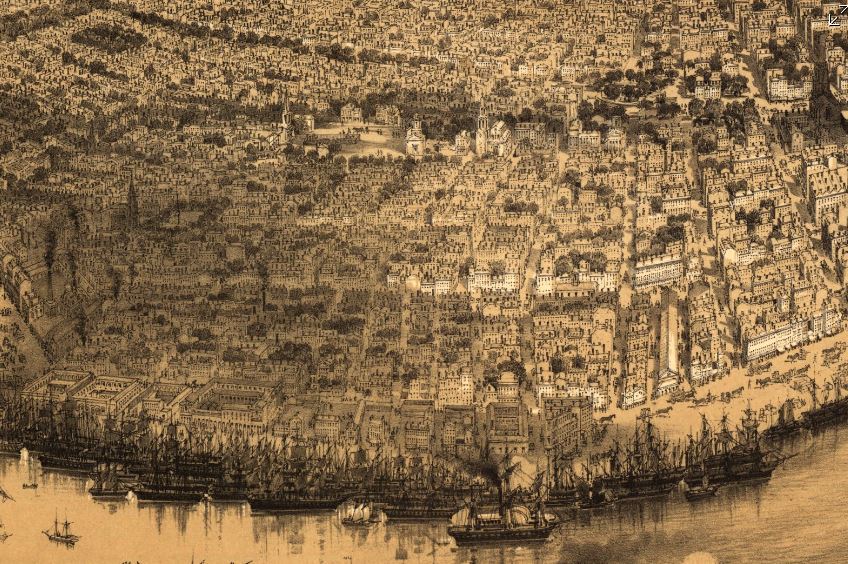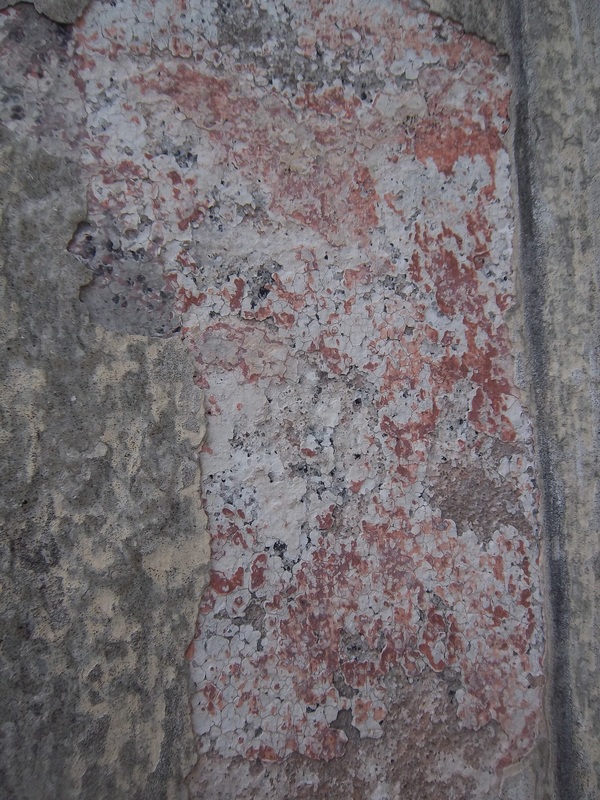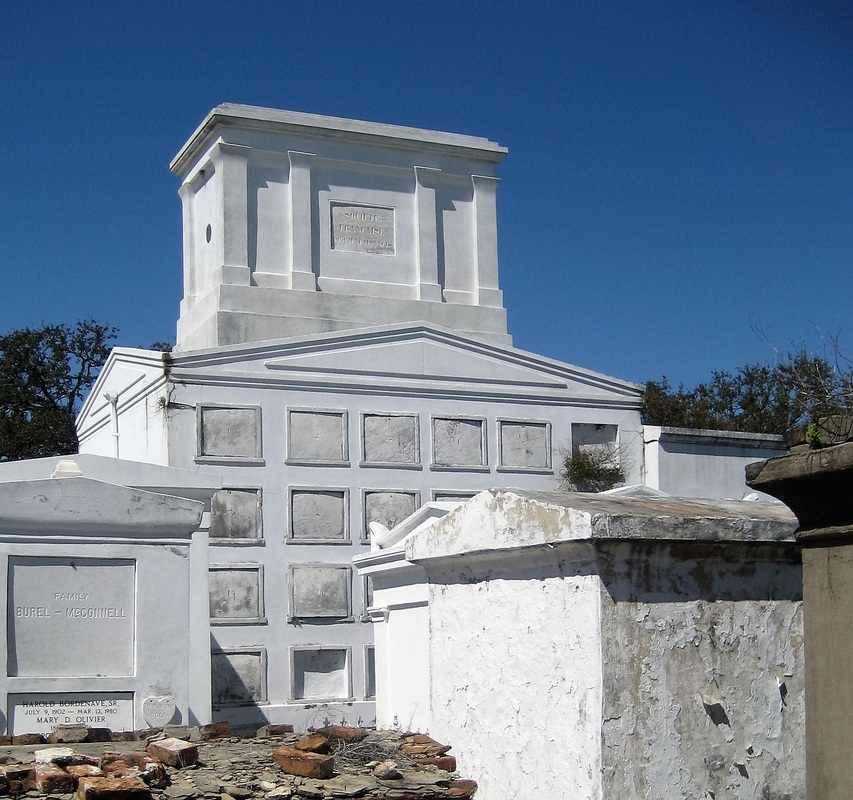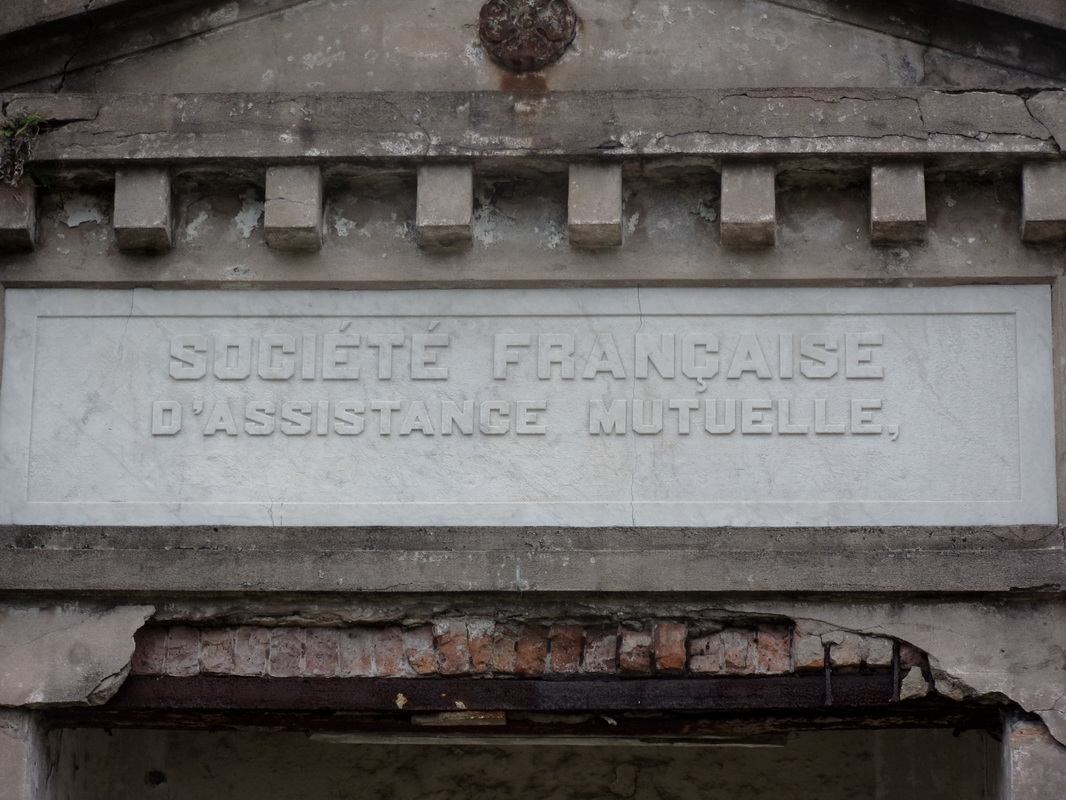|
Published 144 years ago today in the New Orleans Times-Picayune, an interview with the assistant sexton of Lafayette Cemetery No. 1. It’s unclear how much of this article is speculative or fanciful, but in any case its content is fascinating. The article is presented here in pieces, with background inserted regarding the content. Original Times-Picayune narrative from July 13, 1873 is indicated in italics. Sitting on a Tombstone TALK WITH A GRAVEDIGGER --- “How long wil a man lie i’ the earth ere he rot?” [Hamlet] A reporter of the PICAYUNE, chancing in his peregrinations to stroll into the Washington Cemetery[1] in the cool of early morning, met and engaged in conversation with the assistant sexton. The term “sexton” is given to a person who maintains a cemetery in a professional capacity. It originated with a religious connotation, indicating a man who cared for both the church building and the adjoining cemetery. Later, as more and more cemeteries were established outside parish land, the term “sexton” migrated to the secular sphere. Lafayette Cemetery No. 1 was founded in 1833 as a municipal cemetery, and thus was never religiously affiliated. In 1873, the sexton of Lafayette Cemetery No. 1 and 2 was Joseph F. Callico (1828 – 1885). Callico was a free person of color who worked for most of his career beside St. Louis Cemetery No. 2, and also beside fellow stonecutter Paul Hippolyte Monsseaux. Around 1870, when Monsseaux himself ceased his business, Joseph Callico moved to Washington Avenue to serve as the sexton of the Washington Cemeteries. By 1875, he returned to St. Louis Cemetery No. 2, where his brother Fernand served as sexton.[2]
“Well, you know,” said the man, “there is a great difference in them. There are some here who, from their particular situation, keep much longer than others. There’s a man I came across the other day, digging a foundation for a tomb, who had been in the ground for two years, and he was in remarkably good condition. It is true, he was near the wall, and the drainage was good.” This passage offers some confirmation of what the landscape history of Lafayette Cemetery No. 1 suggests: that earlier below-ground burials were replaced by above-ground tombs. Dr. Bennett Dowler wrote in 1852 that Lafayette Cemetery No. 1 was a primarily a belowground cemetery, owing to the preference of Irish and German immigrants for inhumation over tomb burial.[4] Pre-1850’s burials in Lafayette No. 1 are difficult to find today, but most of which remain show some modification over time, suggesting that the assimilated children and grandchildren of immigrants later converted their family lots to traditional New Orleans tombs. This could be one reason the sexton came upon a burial while constructing a new tomb. The gravedigger expands on this notion in his next answer. “Do they bury many in the ground now in this cemetery?” “No,” said he “in this place most everyone has a tomb. You know, this yard has been buried some ten times over, and people don’t care to put their friends under earth when tombs don’t cost much more.” While “ten times over” may be exaggerated for Lafayette Cemetery No. 1 in 1873, the cemetery was declared “full” by Lafayette and New Orleans city councils in 1847 and 1856, respectively.[5] Neither of these ordinances was paid much mind, and burials continued. Furthermore, in the earliest years of the cemetery, between 1833 and 1853, approximately 30% of the individuals listed in interment books are noted as enslaved people. Amounting to thousands if not tens of thousands of burials, records do not indicate their location, although they are unlikely to be in the cemetery wall vaults.[6]  Excerpt of Lafayette Cemetery No. 1 interment books for August 1843. Over this week, burials included two deaths from dysentery, a twenty year old enslaved woman who died of consumption, and a death from "mania a potu," an historic term for alcohol-related illness, including delirium tremens. (New Orleans Public Library) From here both gravedigger and journalist get grim: “From your experience, what part of the body is the first to suffer from the effects of decomposition?” “The head goes first always. You see there isn’t so much flesh about it, and it doesn’t take long for it to go. The other parts go after it very soon; they all seem to go together.” While the good taste of asking this question in the first place is suspect, it is interesting to note the anachronism. In 1873, embalming had only recently become a possibility. The widespread practice of embalming starting in the twentieth century certainly affected the decomposition patterns of burials in New Orleans tombs and elsewhere. “In digging about these unoccupied places, do ever meet with the remains of human beings?” asked the reporter. “Oh, yes. The whole of Lafayette Cemetery has been filled, even to the avenues. When this was first a graveyard, it was not laid out regularly, and now when we have to repair the walkways, the bones are always turned up.” Prior to cement paving and other improvements that took place beginning in the 1940s, Lafayette Cemetery No. 1’s aisles were paved with crushed shells, marble pavers, and slate flagstones. Some of these paving materials remain visible. Archaeological test pits executed in the 1980s and 1990s indicated that crushed shells were regularly hauled into the cemetery to repave aisleways. This is likely the “repair to the walkways” the sexton mentions above. [more unnecessary description of decomposition] “Is there any difference between burying in the ovens and in the ground?” “Oh! Yes. In the ovens they don’t last six months, for with the metallic cases it does not take much time to destroy everything. In the ground, metallic cases, if they are good, last twenty years, and wooden ones about three."
"Yes! I have noticed that when they take on most they generally don’t come back to put flowers on the tomb much after the first month. “The widows come every week for about a month or two, fixing up everything. When they cry most they don’t come back at all, but when you see one who looks all the time at the coffin and doesn’t make a fuss you can be sure she will put flowers there for years.”
[1] Historically, Lafayette Cemetery No. 1 is frequently referred to as “the Washington Cemetery.”
[2] Louisiana State Board of Health, Biennial Report of the Louisiana State Board of Health, 1883-84, 40; Edwards Annual Directory…in the City of New Orleans for 1872 (New Orleans: Southern Publishing Company, 1872), 86; Edwards Annual Directory for New Orleans 1873 (New Orleans: Southern Publishing Company, 1873), 90; United States Census, 1880, New Orleans, Louisiana, Roll 461, Page 234C. [3] “All Saints’ Day – The Living Remember the Dead,” Times-Picayune, November 2, 1873, 1. [4] Bennet Dowler, M.D., “Tableaux, Geographical, Commercial, Geological and Sanitary of New Orleans,” printed in Cohen’s New Orleans and Lafayette Directory for 1852 (New Orleans: Office of the Daily Delta, 1852), 21. [5] Mayoralty of New Orleans, Common Council, City of New Orleans, “An Ordinance Relating to Cemeteries and Interments,” Daily Creole, December 30, 1856, 4. [6] New Orleans Public Library, Lafayette Cemetery No. 1 Interment Records, Vols. 1-5, microfilm. [7] Dowler, 21.
9 Comments
New Orleans is home to dozens of cemeteries, each with its own character and history. Among these many burial and interment grounds are the influences of world cultures, human expressions of grief, and iterations of architecture that, in one way or another, are recognized as significant on small and large scales. Some are more appreciated than others. Some have been lost entirely from the landscape, such as St. Peter Street Cemetery, Girod Street Cemetery, or Gates of Prayer Cemetery on Jackson Avenue. Yet among these recognized and unrecognized burial grounds, there is one nearly always omitted, even though people walk by it and photograph it every day. Tucked behind St. Louis Cathedral and often overshadowed by the looming statue of the Sacred Heart of Jesus, is the final resting place of nineteen French navy men who died in 1857 and were re-interred at this place in 1914.
In the years following this harrowing incident, the surviving crew of the Tonnerre and their families in France, as well as French naval authorities, sought to memorialize the lost sailors. A monument was erected in the Quarantine Station cemetery in August 1859. The marble obelisk would not be seen for long, however. The Quarantine Station was soon relocated, with the former site abandoned. The monument would not be rediscovered until 1914, when Andre Lafargue endeavored to reclaim it.[3] The tale of the Tonnerre, its crew, and its monument, highlights so many historical aspects of the mid-nineteenth Caribbean and Atlantic world. It is a story of memorialization and reclamation, of the interactions between cultures and nations, and of the management of public health in this time. In this post, we seek to unpack some of these curious aspects of the monument that rises so subtly from behind St. Louis Cathedral. The Ship Tonnerre The Tonnerre is referred to in historical documents as both a corvette and an aviso or “advice ship.” While there appears to be some distinction between the two (and we don’t presume to call ourselves naval historians) – for example, avisos are customarily smaller than corvettes – documents consistently refer to the Tonnerre as a ship assigned the duty of relaying messages between larger naval commands. The four-gun Tonnerre was a steam-powered vessel, propelled by a paddle, and was inducted into service by the French Navy at Indret in 1838.[4] By 1850, the French Navy had about a dozen such first class “advice boats,” including five constructed of iron (Le Mouette, Le Heron, Le Eclaireur, Le Requin, and L’Epervier), although the Tonnerre was not constructed of iron. By 1857, the Tonnerre and its crew had already completed service in the Crimean War (1853-1856) in which an alliance of European powers fought Russia for influence over the Black Sea and Middle Eastern. Lieutenant Clement Maudet, who came to command the Tonnerre, fought with the French Foreign Legion in Crimea, earning a medal for his bravery. Many of the other sailors aboard the Tonnerre served in this conflict before being dispatched to the Caribbean. The presence of the Tonnerre in the Caribbean also highlights the colonial and military interactions in the Caribbean and Atlantic world at the time. The Tonnerre was charged with relaying messages between Vera Cruz and Havana (a role the ship would serve through the late 1850s).[5] The ship’s mission likely related to French economic and political interests in Mexico, which Emperor Napoleon III viewed as critical to Latin American trade access. French intervention would escalate to full on invasion in 1861, and later the unsuccessful installation of Hapsburg emperor Maximilian I. It was in this conflict in 1863, that Lieutenant Clement Maudet would die of wounds acquired in the Battle of Camerone.[6] The Tonnerre was the fifth ship of the French navy to bear this name. The first French Naval Tonnerre was the British HMS Thunder, captured in 1696. The Tonnerre under Maudet’s command in 1857 was retired in 1878. The French Navy currently operates the eighth Tonnerre, placed into active service in 2006. The Crew The Tonnerre had an original crew of eighty sailors, including a doctor (who died of yellow fever at the Quarantine Station), sailors, ensigns, stokers (steam engine operators), chefs, and mates. Eighty of whom contracted yellow fever either in Mexico, Louisiana, or Cuba. Thirty of these seamen died. Two of the chefs aboard the Tonnerre who perished in 1857 appear to have been of Italian descent: Giovanni Carletto and Jean Janotti. Ages of the men who died aboard the Tonnerre are not listed.
In 1853, for example, the fever was presumed to be caused by “miasmas” or “bad air” (a theory derived from Enlightenment thought), and thus the City burned torches of pitch and discharged cannons in order to disperse airborne maladies. By the 1850s, the Sanitarian movement had begun to marginally influence public health, focusing on cleanliness of public spaces and the removal of fetid water. Quarantine Stations were present in most eastern seaboard cities by the early 1800s. In New Orleans, the necessity of such stations was frequently debated and they were often decommissioned. In many cases, New Orleans merchants were staunch opponents of quarantine. Such systems, they said, disrupted commerce and were thus unacceptable. Their arguments appeared validated when, on occasion, epidemics broke out despite the presence of quarantine stations – likely due to the yellow fever mosquito (Aedes aegypti)’s fondness for sheltering in ship cargo holds. Incidentally, however, 1857 was not a significant epidemic year for New Orleans. As the Tonnerre had no intention of docking in the City en route to Havana, the condition of this one ship’s crew posed little danger of epidemic to the Crescent City.
The Quarantine Station would be abandoned after the 1860s, after the US Government established an additional Quarantine Station at Ship Island, Mississippi. In 1880, the Louisiana Board of Health reported on the condition of the Ostrica-area Station, the grounds “open and roamed over by cattle.[10]” It described a complex of several buildings: a fever hospital, a pox hospital, a medical residence, a boatmen’s quarters, and a warehouse. Said the board of the process of disinfection at the hospitals: The process of disinfection now employed consists of burning sulphur in iron pots. These pots are placed in tubs containing water. This method is liable to the grave objection that there is, in many cases, and especially during rough weather, danger of firing the ship.[11] In this report, the Board of Health appears to be investigating the feasibility of placing the Station back into service, although no evidence suggests this happened. However, the report documented the enduring presence of the Tonnerre monument: The graveyard of the Quarantine Station is located about 200 feet to the rear of the Fever Hospital, and is surrounded by a rude fence and covers about three-fourths of an acre. Marks of about one-hundred graves can be discerned by the inclosure [sic], which are thickly covered with tall grass, brambles, and shrubs. There is only a solitary marble monument, which bears the following inscription: "A la mémoire de Trente Marins, faisant partie de l'équipage de l'avito vaisseau de la Marine Imperiale le Tonnerre, décède à la Quarantaine de la Nouvelle Orléans en Août, 1857. Erige par l'Odre de S.E. L'amiral Hamelin, ministre de la Marine de l'Empereur Napoléon III.”[12] The Monument Thanks to donations from the families of surviving Tonnerre crewmen, a marble monument was installed at the Quarantine Station in 1859. Unfortunately, the craftsperson that designed and built it is unknown. Photos from the monument’s recovery indicate that it was originally a marble-clad box tomb, with fluted corner pieces and a marble slab atop which the monument’s obelisk and urn were fixed. This style of memorial was typical of 1850s high-style cemetery architecture in both New Orleans and France. Derived from sarcophagus designs, similar monuments can be found in the cemeteries of Montparnasse (France) and St. Louis Cemetery No. 2, although less modified versions are visible in the upriver parishes. The Tonnerre monument was described intact by the Louisiana Board of Health in 1880, even though the Quarantine Station cemetery had become derelict. Andre Lafargue shares a similar recollection from his youth, seeing the monument ascending from the brush as he traveled the river. Lafargue notes that at some time between 1880 and 1914 the obelisk fell in a hurricane.[13] The Quarantine Station long abandoned, without intervention the Tonnerre monument would have sunken beneath overgrowth and debris. Yet in 1914, Andre Lafargue, who at that time served as the attorney for the Comité du Souvenir Francais, came across in the French Society records documentation of the Tonnerre monument. In an effort that proved fruitful if not also tremendous and risky, Lafargue chartered a boat from Buras to Ostrica, bringing with him the vice French consul general at the time, Andre Lacaze, and their wives.[14] Trudging through the brush with only a vague recollection of where the cemetery and Quarantine Station once stood, the party discovered the remains of the monument: We finally came to a spot, near a tree of greater dimensions than the others, and there found traces of former habitations, and all of a sudden our feet struck a pile of bricks and pieces of marble and we knew, after examination of the fragments, that we had finally found the spot where the cemetery stood long years before and where the monument had been built. The ladies, highly elated by the discovery, were very helpful in picking up various pieces of the pedestal and we finally located the obelisk, the main section of the most important part of the monument, and the gracefully draped urn. The urn had been wrenched from the top of the obelisk and the latter had broken into two pieces in its fall to the ground, after the pedestal and the foundation had been undermined by the elements and the rough usage of time.[15] Over the course of subsequent trips to the site and through partnerships with groups like the Societe de Bienfaisance et d’Assistance Mutuelle, the monument was packed away and sent upriver to New Orleans. Despite the contestations of local undertakers that recovery of the remains of the 19 seamen who died at the Quarantine Station would be impossible, Lafargue and his crew set out to disinter each one. Each body was laid beneath the flag of France during disinterment, then shrouded and placed together in a metallic casket, where a single French flag was draped across them. In an additional gesture of reverence, the party uprooted a small tree from the cemetery and placed it in the coffin with the remains, to be re-planted at the new monument site.[16] The monument was reconstructed by New Orleans stonecutter and tomb builder Albert Weiblen. Weiblen built a burial vault atop which the monument would sit and bordered with a Georgia Creole marble coping wall. This vault forms a tumulus structure and simultaneously elevates the monument. Weiblen’s skill in reconstructing the monument is remarkably evident: it is difficult to determine which elements of the monument are replacements and which are original. But some clues are visible: one inscribed tablet is of a slightly different type of marble, and is inscribed with a pneumatic tool, whereas the other inscribed faces of the pedestal have smaller, hand-carved lettering. It appears as if the monument itself may have been slightly downsized, it’s dimensions shaved away to remove damaged or unsalvageable elements. A small bronze plaque was installed at the front of the coping by De Lucas Monument Company at the cost of $13.[17] Since its rededication, the Tonnerre monument has survived a few more hurricanes, and an instance in the 1930s in which an inebriated driver crashed through the gates of the Cathedral garden and toppled the obelisk. But for the most part the monument (and the remains therein) have known peaceful repose, quietly situated between St. Louis Cathedral and Royal Street, so often escaping notice. [1] Andre Lafargue, “The Little Obelisk in the Cathedral Square in New Orleans,” Louisiana Historical Quarterly, Vol. 28, No. 1 (Jan. 1945), 329.
[2] Every history of the Tonnerre’s trials at the Louisiana quarantine station omits the commander’s first name. Based on other histories of the French Navy in the Baltic and Mexico, and other statistical data, the commander of the Tonnerre was most likely Clement Maudet (1829-1863), French Legionnaire, who would die later in Mexico during the Battle of Camarone, part of the Second French Intervention. [3] Ibid., 333-336. [4] John Fincham, A History of Naval Architecture, to which is prefixed an introductory dissertation on the application of mathematical science to the art of naval construction (London: Whittaker and Co., 1851), 408. [5] French war steamer Tonnerre embarks from Havana to Mexico, Daily Picayune, October 21, 1857; French war steamer Tonnerre returns to Havana, Daily Picayune, December 14, 1857. [6] This is an extremely generalized recapitulation of colonialism in the Caribbean in the 1850s. For further reading see: The Second French Intervention in Mexico, The French Intervention in Mexico and the American Civil War, and if all of this is too complicated or frustrating, just check out this fun comic. [7] Henry Rightor, Standard History of New Orleans, Louisiana (New Orleans: Lewis Publishing Company, 1900), 211-213. [8] John Duffy, The Sanitarians: A History of American Public Health (Chicago: University of Illinois Press, 1992), 60; Joy J. Jackson, Where the River Runs Deep: The Story of a Mississippi River Pilot (Baton Rouge: LSU Press, 1993), 55; Alcee Fortier, Louisiana: Comprising Sketches of Parishes, Towns, Events, Institutions, and Persons, Arranged in Cyclopedic Form, Vol. 2 (Century Historical Association, 1914), 337. Jackson notes quarantine stations located at Cubit’s Gap (around 1910) and a post-1920 station at the lower end of Algiers. Andre Lafargue describes a quarantine station at Pilot Town, twenty miles downriver from Ostrica, by 1914. [9] John Duffy, ed. The Rudolph Matas History of Medicine in Louisiana, Vol. II (Binghamton, New York: Vail-Ballou Press, Inc., 1962), 185-186. [10] Joseph Jones, M.D. Report of the President of the Board of Health of the State of Louisiana for the Year 1880, 14. The report also notes the success of quarantine measures for that year, including the removal of the bark Excelsior, bound from Rio de Janiero, to Quarantine, which “certainly freed the city of New Orleans from the infected crew, and in the opinion of a portion of at least of the medical profession, preserved the citizens from an epidemic.” [11] Ibid., 18. [12] Ibid., 15. [13] Andre Lafargue, “The Little Obelisk in the Cathedral Square in New Orleans,” 336. [14] John Smith Kendall, A.M., History of New Orleans, Vol. III (Chicago: Lewis Publishing Company, 1922), 1149. [15] Ibid., 338. [16] Ibid., 336-342. There is no indication that this tree remains in the garden behind St. Louis Cathedral. [17] Receipt from De Lucas Monument company to Comite Francaise, Andre Lafargue papers, MSS 552, Folder 10, Tulane Louisiana Research Collection. This blog post was inspired by the photos within, most of which were taken by Robert W. Kelley of LIFE Magazine in 1957. These images show Girod Street Cemetery in its final moments, as well-dressed adults and children mill around its collapsed tombs and open vaults, with newly-built New Orleans City Hall present in the background of many shots. Mis-labeled “Gerard” Street Cemetery, they offer a vignette of what has long since disappeared from the New Orleans landscape. The full album can be found via Google Cultural Commons here. The topic of Girod Street Cemetery is one that comes up in a few varieties of conversation among New Orleaneans, most often related to the charming notion that the Louisiana Superdome was built atop the burial ground (it wasn’t, per se). The relationship of the old cemetery, known also as the Protestant Cemetery, to the New Orleans Saints football team is one that has been described many times over, best by Richard Campanella and Doc Boudin of Canal Street Chronicles. Check them out to see why you can’t blame the vengeful dead for a losing season. The Protestant Cemetery, 1822 – 1940 The former footprint of the cemetery, however, was indeed quite close to the present-day Superdome. Originally bounded by Liberty, and the former Cypress and Perillat Streets, the cemetery once stood beneath where Superdome parking garages and the Champions Square complex now rise. Founded in 1822, this once-distinctive cemetery lay at the terminus of Girod Street. Previous to that date, non-Catholics were buried in the rear of St. Louis Cemetery No. 1. The narrow “Protestants Section” in St. Louis No. 1 was once much longer, but was truncated after construction to Treme Street in 1820. Shortly afterward, Episcopal Christ Church was awarded the land that became Girod Street Cemetery. Over the course of the nineteenth century, Girod Street Cemetery developed into a landscape distinct from its New Orleans cemetery sisters. As the second-oldest cemetery in the city, it amassed the vestiges of early cemetery architecture, from single-vault, stepped-roof structures to more ambitious marble-clad and Classically inspired sarcophagus tombs. The tomb of Angelica Monsanto Dow, who died in 1821, reflected this aesthetic well. Girod Street Cemetery furthermore was an “American” cemetery, in that it became the final resting place for many New Orleans residents who had travelled from elsewhere, particularly the Anglo-American north and Midwest. From these outsiders came tombs and materials inspired by northern cemetery designs – clean, wire-cut Philadelphia brick, liberal use of stone urns and many, many obelisks. Girod Street Cemetery kept within its walls a tableau of cemetery artisanship that stood out from the landscapes of its sister Catholic, municipal, and fraternal cemeteries. Through the nineteenth and into the twentieth century, Girod Street Cemetery would become the final resting place for many New Orleaneans of distinction. Heroes of the Mexican American War, civic leaders, and prominent families utilized the burial ground. One estimate suggested that the cemetery was once home to 100 society tombs. For comparison, Lafayette Cemetery No. 2, which is usually noted for its society tombs, has just twenty. In Girod Street Cemetery, the tomb of the New Lusitanos Benevolent Society was likely the most notable. Designed by J.N.B. de Pouilly and erected in 1869, the tomb had 100 vaults and a walk-in vestibule framed with a Classical portico. Being somewhat centrally located, Girod Street Cemetery was also heavily utilized as a public burying ground in times of epidemic. It seems as though nearly every major epidemic of the nineteenth century involved a terrible debacle at Girod Street Cemetery, in which bodies were stacked beyond capacity with no one to bury them. This may have also been due to the presence of a de facto Potter’s Field adjoining the cemetery, which was described as early as 1837: “This latter receptacle of the dead [the Protestant cemetery] has for many years been a disgrace to New Orleans. Once the Potters’ Field, it soon became the public burying ground, provided you were able to pay for a vault – otherwise you had to be sent further out into the swamp.”[1] The 1833 cholera epidemic in New Orleans proved especially tragic for Girod Street Cemetery, although it was not necessarily the last time the cemetery fell prey to insufficient manpower in the face of great loss of life: … the unshrouded dead dumped at the gateway of the Girod Street Cemetery accumulated in such numbers that the entrance to its precincts was so obstructed that arriving bodies had to be deposited on the outside; no graves at this time could be dug; no coffins were procurable, for there were neither grave diggers to be had nor undertakers to be found. The City Council was forced to order out the chain gang ‘prisoners’ from the city jails, to dig a trench the whole length of the lower side of the cemetery. It was dug some twelve or fifteen feet wide, and as deep as the filtering water soil would permit, into this receptacle the decomposing bodies were dragged by hooks from the fire companies, without the formality of precedence or order of any kind. As a part of the trench was filled, the earth taken from it was heaped upon the remains of the rich and the poor, the aged and the young.[2] This mass grave would eventually be erroneously referred to as the “yellow fever mound” in later years. In the late 1940s, historians would determine that this feature was in fact the burial of 1833 cholera victims.[3] The Back of the Swamp Girod Street Cemetery, for its stately obelisks and high society residents, would be plagued with issues surrounding its management and topography for most of its existence. In the 1830s, only years into its functional life as a cemetery, it would be noted that its vaults were built with only one brick thickness to their walls, which permitted the “escape of unhealthy odors.”[4] However this was not an issue exclusive to Girod Street – City ordinance did not regulate the quality of tomb construction until the 1850s. What did afflict Girod Street perhaps more than other cemeteries was its location in significantly low-lying land. Girod Street Cemetery swelled with feet of water in Sauve’s Cravasse of 1849, and frequently took on water in other instances, owing to its place on swampy land. In 1880, a special commission of Louisiana state representatives assessed the condition of New Orleans cemeteries and found them all to be in “proper” condition – with the exception of Girod Street Cemetery. Noting, “in the event of rain [Girod Street Cemetery] is always flooded to such an extent that it will affect the sanitary precautions necessary to prevent the contracting or spreading of any diseases,” the commission recommended the cemetery be closed. This recommendation was apparently declined.[5] Girod Street Cemetery’s troubles would not end there. The Fall of Girod Street Cemetery Through the course of its existence, Girod Street Cemetery was owned and operated by Christ Church Cathedral. Until the mid-twentieth century, most religiously-affiliated cemeteries were managed by the respective congregation that owned them. These congregations appointed a sexton or caretaker to manage them by performing burials, building tombs, and keeping records. Although city law required sextons to compile records to be submitted to the Board of Health, the interment records of each cemetery were kept by each sexton to varying degrees of organization. At the turn of the century, increasing industrialization of the monument trade shifted the role of sexton away from groundskeeper and toward that of a sales agent. In some cases, this meant a decline in peripheral duties. This shift is often credited for the lessening of care for the cemetery, as is the inclination of families to move their loved ones remains to newer cemeteries (namely Metairie Cemetery, established 1872). Lack of sellable space and changing racial demographics in the neighborhood of Girod Street Cemetery are also noted as causes for decline. For any combination of these reasons, or others, the administration of Christ Church found themselves in a difficult bind with their cemetery.[6] By the early 1940s, reports on the condition of Girod Street Cemetery appear to have drastically worsened. Wrote one reader in a 1943 letter to the Times-Picayune: … I was horrified to find many of the tombs broken open and others completely destroyed. There was a large fire burning at the top of one of the tombs. I saw what looked like wooden boxes burning. The cemetery looks more like a poultry farm. Atop the tombs are a number of chicken coops, and chickens wandering everywhere, and some of the lovely trees are completely or nearly burned down. Where are the owners of these tombs, that such desecration is allowed? And who cares for this unfortunate burying place?[7]
By the time of this announcement in 1947, Girod Street was merely joining in a much larger phenomenon in which cemetery management was drastically changing. In 1945, the City of New Orleans eliminated the position of sexton from the six municipal cemeteries. In the years following, former sextons and stonecutters would go into business for themselves as cemetery owners, profiting primarily from streamlined materials and low overhead costs. This process was best accomplished by Albert Weiblen, who eventually purchased Metairie Cemetery, and the Stewart family, who built Lake Lawn Park in the 1950s. However, this approach relied on the cemetery having lots available for sale. The last sexton of Girod Street Cemetery, Eugene Watson, died in 1950. In 1948, Christ Church ran multiple notices enjoining tomb owners to repair their property. However, as the cemetery owners pushed to bring the burial ground into the twentieth century, they would stumble over technicalities of property ownership, prohibitive costs, and a booming, modernizing world slowly encroaching on the Girod Street walls. “An Eyesore in the Midst of Progress” The Post-World War II era brought huge changes to nearly every facet of American life. In the cemeteries, everything from materials to business models to the funeral industry transformed. In the American city, revolutionary ideas of urban renewal swept through downtowns, destroying historic districts and erecting aggressively modern new landscapes. In New Orleans this urban renewal took place with mayor deLesseps “Chep” Morrison, and it took place along Loyola Avenue, where historic buildings were swept away for a new library, city hall, and train depot. The intersection of Liberty and Girod Street, at the boundary of the cemetery, was awkward and could not adequately accommodate recently increased truck traffic volumes. By the late 1940s, even the federal government eyed the Girod Street property as a potential site for a new post office and federal building. In the light of rapidly encroaching superhighways and new urban landscapes, Girod Street Cemetery became even more anachronistic. Perceived as an affront to the bright future of the city’s civic heart, plans to renovate the cemetery fizzled into outright demolition by neglect, aided by the agenda of modern city leaders. Lack of care led to vandalism, which led to inevitable decries that the cemetery was too broken to be fixed. In June 1948, city workers arrived at Girod Street Cemetery and knocked enormous holes in the perimeter wall, hauling away five truckloads of bricks. After protests from Christ Church, Mayor Morrison simply responded that he didn’t realize there would be an objection.[12] In 1954, the City of New Orleans successfully expropriated more than twenty thousand square feet of the cemetery for the purposes of widening Liberty Street. In addition to this seizure of land, city council furthermore requested the mass removal of all remains from the cemetery entirely, and that they be removed to newly-finished Lake Lawn Park, a for-profit venture of the Stewart family.[13] Girod Cemetery is Calling Days after the announcement of the expropriation, city attorneys placed ads in newspaper enjoining any person with family buried in Girod Street to contact the City. Attempt to salvage burials, tombs, sculpture, and any other remaining resource of the cemetery were launched. Many of these reburials had already taken place in years previous by families who suspected the cemetery’s demise. In 1955, the remains, tomb, and monument of Lt. Col. William Wallace Smith Bliss was removed to namesake Fort Bliss in Texas. The Louisiana Landmarks Society led this effort, as it did other efforts to locate families associated with the cemetery. In June of 1955, the city officially purchased the cemetery. In January 1957, it was deconsecrated. Only months later, Louisiana Landmarks member and remarkable cemetery historian Leonard Victor Huber decried the demolition process at the cemetery: “Another 60 days and there will be nothing left of Girod Street cemetery but a memory. Tombs are being broken up… I was in a garden recently with its walls built of marble slabs from the cemetery.[14]” Through the course of demolition, remains of white descent were reinterred at Hope Mausoleum, owned by Leonard V. Huber. African American burials were removed to Providence Memorial Park. In October 1958, Christ Church sold 96,000 remaining square feet of the cemetery to the federal government for nearly $300,000. This sale would transform sections of the cemetery into a parking garage for a planned post office and federal building on Loyola Avenue. Said Frank Schneider of the Times-Picayune, “Girod became an eye sore in the midst of progress but now it will contribute something to New Orleans’ changing skyline. The 14-level post office structure will be the largest federal building in the Deep South.”[15] Learning from Girod Street Although certainly accelerated by ambitions of new urbanism, the issues that led to the demolition of Girod Street Cemetery are the same issues that regularly appear in discussions of historic cemetery management today. The power of the cemetery authority to manage abandoned tombs and lots is a topic of constant contention. Cemetery owning bodies today can write off issues of abandonment by appealing to private property rights, and nearly in the same breath demolish lots that become hazardous or inconvenient to redevelopment. The ability to be conveniently selective regarding Louisiana cemetery law has, in many cases, enabled neglect. This neglect, of course, contributes to cyclical issues of cemetery vandalism, which often goes unabated until conditions are perceived as unsalvageable. The sweeping demolitions that took place across the United States during the 1940s through the 1960s spawned a revitalization of the American historic preservation movement. Iconized by the demolition of Pennsylvania Station in New York in 1963, fatigue over the loss of entire historic districts led to the passing of the National Historic Preservation Act of 1966 which, among other things, would have likely prevented the Federal government from purchasing portions of Girod Street Cemetery. The tale of Girod Street Cemetery is comprised of much more than a haunted sports arena. For cemetery preservationists in New Orleans, it is a cautionary tale that should never be too far from one’s mind. The stunted successes and disappointing failures could easily revisit any of our burial grounds. [1] “New Orleans Grave Yards,” The Picayune, September 19, 1837, 2.
[2] Daily Picayune, August 21, 1885, 2. [3] Leonard Victor Huber and Guy F. Bernard, To Glorious Immortality: The Rise and Fall of Girod Street Cemetery, New Orleans’ First Protestant Cemetery, 1822-1957 (New Orleans: Ablen Books, 1961). [4] “New Orleans Grave Yards,” The Picayune, September 19, 1837, 2. [5] Louisiana State House of Representatives, Official Journal of the Proceedings of the House of Representatives of the State of Louisiana (New Orleans: The New Orleans Democrat Office, 1880), 285. [6] “The Crumbling World of Girod Cemetery,” Dixie: Times-Picayune States Roto Magazine, August 29, 1954, 6-7. [7] “Historic Cemetery Neglected,” Times-Picayune, June 23, 1945, 10. [8] “Old Cemetery to be Rebuilt,” Times-Picayune, December 21, 1947, 3. [9] “Threaten Razing of Vaults, Tombs, Fate of Old Cemetery to Rest with Lot Owners,” Times-Picayune, October 23, 1945; “Girod Cemetery Inspection Made,” Times-Picayune, October 30, 1945. [10] “Zulu Chief’s Wish to be Buried with Pomp and Ceremony Fulfilled,” Times-Picayune, August 23, 1948, 24. [11] “Old Cemetery to be Rebuilt,” Times-Picayune, December 21, 1947, 3. [12] “The Crumbling World of Girod Cemetery,” Dixie: Times-Picayune States Roto Magazine, August 29, 1954, 6-7. [13] “Girod Cemetery Strip is Sought,” Times-Picayune, November 12, 1954, 1. [14] “Up and Down the Street: Book on Girod Cemetery Needs Help,” Times-Picayune, August 15, 1957, 19. [15] “Old Burial Spot is Sold as Site for U.S. Garage,” Times Picayune, October 4, 1958, 11. This blog post is Part Two of a two-part piece on the tomb of the Sociètè Française de Bienfaisance et d’Assistance Mutuelle de Jefferson, located in Lafayette Cemetery No. 1. To learn about the history of this French Society, check out Part One here. Recently, Oak and Laurel Cemetery Preservation, LLC transcribed the burial records of the tomb of the Sociètè Française de Bienfaisance et d’Assistance Mutuelle de Jefferson, located in Lafayette Cemetery No. 2, thanks in part to a grant from genealogist Megan Smolenyak. The Society was absorbed by the Sociètè Française de Bienfaisance et d’Assistance Mutuelle de Nouvelle Orléans in 1900. About the Record Books The records of the Sociètè are housed at LSU Special Collections, Hill Memorial Library, in Baton Rouge. (MSS 318, 1012) The burial books appear to have been included with the larger collection of papers from the Sociètè Française de Bienfaisance et d’Assistance Mutuelle de Nouvelle Orléans (French Benevolent and Mutual Aid Society of New Orleans) which absorbed its Jefferson City counterpart in 1900. The collection is comprised of two books, dating from the tomb’s construction in 1872 through 1900. While later interments were certainly made in the Lafayette Cemetery No. 2 tomb, their record appears to have been incorporated into another, as-yet unstudied document. Within these two books are the burial documents for 186 individuals. Among these records, 142 people were buried in the society tomb in Lafayette Cemetery No. 2, 32 were provided formal burial aid by the society and were interred in family tombs throughout the city, and 12 were not specified as to burial location.[1] Each burial record documents the date and place of the individual’s birth, date and place of death, as well as cause of death and information regarding membership. These documents shed light on the lives of hundreds of people. They allude to intricate familial and professional relationships, personal tragedies, and public calamities. They offer a window into a rich community, the vestiges of which stand silent in this stately yet neglected tomb in Lafayette Cemetery No. 2. Today we share the stories of those buried within. The Foreign French: Founding Members and their Origins The Sociètè Française de Bienfaisance et d’Assistance Mutuelle de Jefferson was organized in 1868 by native-born French men – eight of whom are buried in the Lafayette No. 2 tomb. Much like the New Orleans French society, these immigrants sought fraternity among their countrymen. Incidentally (or perhaps not so much so), most of these men were born in the same French provinces (départments), and often in the same village. The majority of adults buried in the Sociètè tomb originated from two primary areas in continental France: the department now known as Midi-Pyrenees, including Gers, Haute-Pyrenees, Haute-Garonne, and Bass Pyrenees (now known as Pyrenees-Atlantiques), and the eastern departments of Alsace-Lorraine, specifically Haut-Rhin, Bas-Rhin, and Moselle. These two areas are nearly as geographically disparate as can be, with the former nestled along the Pyrenees mountains at the Spanish border, and the latter at the Rhine River beside present-day Germany.
In Alsace-Lorraine, a different climate motivated the eventual members of the Sociètè to emigrate from their homes. The Franco-Prussian War (1870-1871) forced many Alsatians from their homeland when the controls of the provinces shifted from France to newly-nationalized Germany. For French-speaking Alsatians, both Jewish and gentile, German citizenship was a less than desirable option. New Orleans was an attractive alternative due to its Francophone tradition. Among these Alsatian emigrants were sisters Catherine and Marie Sonntag, both in their early twenties from Altinstadt, Alsace. Nieces of Sociètè member O.M. Redon, they both died of yellow fever within weeks of each other in October 1872. They were buried in vaults 20 and 22 of the Lafayette No. 2 society tomb. While the people buried in this tomb overwhelmingly shared a linguistic and cultural bond, there is no shortage of strangers among the burials in Lafayette Cemetery No. 2. Although the tomb was built for French society members, those members were not always French. Strangers in a Strange Land: Non-French Buried in the French Tomb A handful of foreign-born non-French people were laid to rest in the Lafayette Cemetery No. 2 society tomb. Their stories contribute to the greater narrative of the society which at its heart was thoroughly New Orleanean in its cultural interactions. From Germany, Catherine Deffenback and brothers John and Jacob Schwenck were buried in this tomb at their time of death. The Schwenck brothers owned a saloon together on Magazine Street.[3] Leon Vignes, from Mont-de-Marrast, France, mourned the death of his Irish-born wife, Margaret, in 1884. She is buried in vault 35. Leon died fifteen years later and was buried in vault 38. He was not the only person to join the matrimonial melting pot: The wife of J.M. Gelé was born in England and died in 1872, buried in vault 26. Perhaps the most interesting foreign-born member of the society is not buried in the Lafayette No. 2 tomb but instead only blocks away in Lafayette Cemetery No. 1, although no tablet remains to mark his name. Louis Savini was born in 1830 in Mortara, Italy. By the time he was eleven years old, he and his family had taken residence in New Orleans. From the very scant documentation remaining, Savini appears to have led a colorful life. He owned a saloon in what is now the Central Business District on Common Street, near the Mississippi River.[4] For reasons unclear from available records, Savini joined the Sociètè Française de Bienfaisance et d’Assistance Mutuelle de Jefferson in 1874. Only months after joining the group, however, Savini was struck down by a “cerebral fever,” which could indicate encephalitis, meningitis, or scarlet fever. He died on June 1, 1874 in his home on Poydras Street. The Sociètè not only furnished his burial in Lafayette Cemetery No. 1, but also provided a procession befitting a French society member. Savini was buried in the tomb of his brother, Paul Savini, in Quadrant 2 of Lafayette Cemetery No. 1. Today, the tomb is in a state of dangerous neglect and has lost the closure tablet bearing Louis Savini’s name. As the Sociètè aged, its members increasingly were New Orleans natives. Over time, both the children of members and other Francophone Louisianans joined, advancing the process of assimilation in a new country. The Family Tomb At least one hundred and forty-two individuals are buried in the Sociètè Française de Bienfaisance et d’Assistance Mutuelle de Jefferson tomb in Lafayette Cemetery No. 2. Some were recent immigrants with little or no family left behind. For a striking number of society members, however, the tomb was the final resting place for multiple generations. It has already been noted that Leon and Margaret Vignes rest near each other in this tomb. They are also interred with their son, Joseph, who drowned at the age of 14 in 1891. He is interred in the same vault as his mother. The Fortassin family likely also utilized the society tomb for the interment of multiple generations. In 1870, twenty year-old Gabriel Fortassin, Jr., arrived in New Orleans from Trie, France. His parents joined him as well. In 1882, he married Alexandrine Claverotte.[5] The two would briefly move to San Antonio, Texas before returning to New Orleans. In his lifetime, Gabriel would bury his parents in the society tomb, as well as five of his infant children. When he died in 1927, he was given a French Society burial in Lafayette Cemetery No. 2.[6] One of Gabriel’s adult sons, Baptiste Fortassin was also buried in Lafayette Cemetery No. 2, in 1929. Two years later, Baptiste’s widow Marie Maille joined him. With no Fortassin tomb in Lafayette Cemetery No. 2, it is very likely they joined their relatives in this tomb, making it the last resting place of three generations of one family, with at least nine burials.[7] Other families utilized the society tomb similarly. Surnames such as Tujague[8], Abadie, Mouledous[9], Vignes, and Carrare appear multiple times through the burial books, representing multiple generations. These records also show combinations of the above-mentioned names, linked by intermarriage. Eleanor Vignes Tujague and Pauline Mouledous Tujague are both buried in the Lafayette Cemetery No. 2 society tomb. Society members formed a strong, interdependent community. They even stood at each other’s deathbeds to witness a last will and testament.[10] Death and burial were only the final threads that tied these French-speaking New Orleaneans together. In life, they lived and worked beside one another. As the French Society of Jefferson, members lived predominately within the boundaries of the former Jefferson suburb (portions of present-day Garden District, Irish Channel, Central City, and Uptown neighborhoods). Burial records note the residences of a multitude of members as near the St. Mary’s Market and along Tchoupitoulas Street. Even more records note residence as simply “aux abbatoirs,” or “near the slaughterhouses.” Which is no surprise: the majorit of members were butchers. A Workingman’s Society The Sociètè Française de Bienfaisance et d’Assistance Mutuelle de Jefferson shared members and celebrated social events with the Sociètè de Bienfaisance des Bouchers, or the French Butchers Society. Their enormous, eighty-vault society tomb remains also in Lafayette Cemetery No. 2. Members of each society lived near the Mississippi River, where cattle were unloaded at river docks. Until the late 1860s, the City of New Orleans had little regulation regarding the slaughter of livestock. Butchers were free to practice their trade where they pleased, usually near a market where they could sell their wares. This changed with a municipal law that required butchers slaughter livestock exclusively in a city-owned slaughterhouse, the goal of which was to prevent public health hazards.[11] Opposition to this law among butchers of both French societies led to civil unrest and years of legal battles. The case finally reached the Supreme Court in a landmark ruling known as the Slaughterhouse Case. Among the French and Butchers societies, the butcher’s trade was passed through generations and within a tight-knit community. Members lived in close proximity to each other, with addresses at Louisiana, Camp, Chippewa, Annunciation, Constance, Josephine, St. Mary, Tchoupitoulas, St. Andrew, Washington, Magazine, and Rousseau Streets. The propensity to take on the butcher’s trade among these society members is truly overwhelming. One casual cross reference of members’ names with an 1878 directory revealed nine butcher/members alive and working at the time: Gabriel Fortassin, Jr., Jean Abadie, Joseph Barrere, Pierre Lacaze, Bernard Lacoste, John William Lannes (Lannis), Pierre Sabatte, and Leon Vignes. The other three members searched, Victor Brisbois, Ulysses Mailhes, and Jacob Schwenck, were all listed as saloon owners or bartenders. Causes of Death If cursory research is to be trusted, the Sociètè Française de Bienfaisance et d’Assistance Mutuelle de Jefferson was populated by close friends who slaughtered animals and served alcohol for a living. When this living ended for each individual, however, the causes varied. It should be noted that 65 of the 142 burials (45%) in the Lafayette Cemetery No. 2 tomb were for children under six years of age. The Fortassin family, who buried five children in this tomb, were by no means unusual in their parental grief. Joseph Bararre and his wife Amanda Mailhes buried four children as well, all of whom were interred in vault 8. The high concentration of child burials in this tomb has a dual explanation. In addition to the well-understood status of childhood illness and mortality in the late nineteenth century, it was also much more likely for a family to bury a child in a society tomb than one built for a family. Married couples without their own family tomb were unlikely to purchase a lot for the burial of a child or stillborn infant. Instead, it was much more affordable to inter the child in a wall vault or society tomb, if available. Furthermore, the spiritual and emotional benefits of society-supported burial of a child were likely comforting. A significant percentage of the 65 infant/child burials were the stillborn or nonviable infants of society members. The other children of the Sociètè died of many common childhood maladies, including lockjaw (tetanus), cholera, croup, seizures, and whooping cough. Six children were listed as having died either of “bad teething” or a jaw ailment. In the nineteenth century, a range of many ailments was attributed to the process of teething in toddlers, including intestinal disease, seizures, meningitis, or even crib death. About half of the burial records in the Sociètè burial book list a cause of death. Among the adult members, most causes of death of typical of the time period: apoplexy, Bright’s disease, consumption (tuberculosis), and yellow fever. Surprisingly, only four burial certificates mark yellow fever as cause of death. This statistical anomaly may be explained by society members being buried hastily during times of epidemic, either in other tombs or too quickly to fill the burial form completely. “A Mort et Sans Espoir de Guerison” A few members, however, appear to have died in a slightly more unusual manner. Among them are:
All of the above-listed men were members of the Sociètè who were buried in the Lafayette Cemetery No. 2 tomb alongside lost children, fellow butchers, and more than a few bartenders, as well as many wives, nieces, and grandchildren. A Community Buried Together Nearly all vestiges of Sociètè Française de Bienfaisance et d’Assistance Mutuelle de Jefferson have faded from popular memory. The tomb itself does not have a single carved name on any of its forty marble vault tablets. Yet within the decaying stucco vaults of this tomb in Lafayette Cemetery No. 2 are the relics of a great communal history that remains vitally significant to New Orleans cultural heritage. It is the hope that this research might connect the descendants of those buried in this tomb with their ancestors. The full burial rolls of interments into this tomb from 1872 to 1900 (up to the society’s merger with Sociètè Française d’Assistance Mutuelle de Nouvelle Orléans) have been uploaded to FindaGrave, in hopes their descendants may find them. The burial books are also available as an Excel Spreadsheet , MS Access Database, or PDF Document. Click here for burials listed by vault number. [1] Unless otherwise noted, all content is referenced directly from the original burial books as transcribed and documented by Oak and Laurel Cemetery Preservation, LLC. Links to these materials can be found at the end of this blog post.
[2] Arnold R. Hirsch and Joseph Logsdon, editors. Creole New Orleans: Race and Americanization (Baton Rouge: LSU Press, 1992), 112. [3] Edwards’ Annual Directory…in the City of New Orleans, for 1872 (New Orleans: Southern Publishing Company 1872), 366. [4] New Orleans City Directory 1870, 531. [5] State of Louisiana, Secretary of State, Division of Archives, Records Management, and History. Vital Records Indices. Baton Rouge, LA, USA. [6] Times-Picayune, August 28, 1927, 2. [7] Times-Picayune, January 18, 1929, 2; [8] To our knowledge, if this family is related to Guillaume Tujague, restauranteur, it is only distantly. [9] Alternately spelled Moledous, Mouledoux, etc. [10] Pierre Lacaze, also from Trie, witnessed Sylvain Tujague’s final will in 1882. Louisiana Will Book, Vol. 21 (1880-1883). [11] “City Litigation,” Morning Star and Catholic Messenger, May 30, 1869, 5. In this article regarding the Butchers’ filed injunction against the City, the author notes their injunction as “a string of reasons as clear and cutting as the keenest cleaver could demonstrate.” Recently, Oak and Laurel Cemetery Preservation, LLC transcribed the burial records of the tomb of the Sociètè Française de Beinfaisance et d’Assistance Mutuelle de Jefferson, located in Lafayette Cemetery No. 2, thanks in part to a grant from genealogist Megan Smolenyak. The Society was absorbed by the Sociètè Française de Beinfaisance et d’Assistance Mutuelle de Nouvelle Orléans in 1900. Through this research and through extended investigation into the history of the society, its members, predecessors, and descendants, a rich portrait of the life of French-speakers in nineteenth- and twentieth-century New Orleans emerged. Today, we share the history of that society and its many milestones, members, and tombs. ARTICLE I: The association aims to improve physical, moral, and political fitness of its members; to lend each other assistance and relief in misery; to promote each other’s wellbeing, by council and by example; to collectively inspire the rights and freedoms of the home in all countries, and the practice of the duties, which alone can make them worthy; these are the primary obligations as members define them. – from the original constitution of the Sociètè Française de Beinfaisance et d’Assistance Mutuelle de Nouvelle Orléans, 1843 (translated from French).[1] The First French Benevolent Society in New Orleans On March 14, 1843, after four years of preliminary incorporation, the Sociètè Française de Beinfaisance et d’Assistance Mutuelle de Nouvelle Orléans (French Benevolent and Mutual Aid Society of New Orleans) was formally established with twenty-seven members. In its own words, the society formed as a result of increasing Americanization of the French colonial city after the Louisiana Purchase and into the Antebellum Era. The Sociètè Française was the first of many organizations in New Orleans with the aim of preserving French language and identity among its members. The Sociètè in New Orleans crafted their organization in the image of fraternal and masonic organizations in France, exemplified by the Grand Orient de France.[2] Similar values were emphasized: brotherhood, charity, social solidarity, and citizenship. The French model of freemasonry also emphasized laicity, or secularism. Among the founding members of the Sociètè in 1843 was a man who himself embodied the political nature of French freemasonry. Pierre Soulé (1801 – 1870) a French native and revolutionary who settled in New Orleans in the 1830s, shaped the early goals and tone of the Sociètè. However, he was elected to the United States Senate in 1847 and thus truncated his involvement. In this year, the Sociètè merged with the French Consulate. Minute books and histories of the Sociètè suggest that after Soulé’s departure, the political aims of the organization were abbreviated in favor of a charitable and social mission.[3] The Sociètè would come to be known for many things – its Bastille Day celebrations, its protection of the French language, its role as the French consulate for some time – but it was likely best known for its Hospital, which was an institution for over a century. French Hospital In the same year as the Sociètè’s founding, a French visitor to New Orleans donated thirty thousand bricks for the construction of a place in which the members could gather. The material was used to build the first French Hospital on Bayou Road near North Robertson Street, described by historians as “a center-hall, gable-sided, double galleried residence.[4]” The hospital, or Asile de la Société Française, cared for Sociètè members and their families. From 1847 to the early 1860s, the organization weathered multiple yellow fever epidemics in which as much as half of the membership was hospitalized.[5] In the early 1860s, the Hospital moved to St. Ann Street, a property donated by then-President Olivier Blineau. Blineau died shortly thereafter and was given the posthumous title of “Father of the French Society.” Originally meant only for society members, French Hospital was opened to all sailors of the French fleet in November 1862, in the event that an illness may require a stay on land.[6] With few exceptions, the Hospital was expressly for the use of members, their families, and those sponsored by members until 1913. In 1913, French Hospital expanded under the decision that “it was finally decided to build a clinic to treat strangers.[7]” Over the next thirty years, the Hospital would include a maternity ward, modern X-ray machines, and operation rooms. The original 1913 building became a well-known edifice on Orleans Street near Claiborne Avenue.[8] Tombs and Burial Benefits Throughout New Orleans history, it was common for societies to form around commonalities of nationality, profession, or background. Most societies would provide benefits similar to those provided by fraternal orders or by modern-day insurance companies. Among these benefits was frequently the option of burial in a society tomb, as well as funereal benefits for survivors. The Sociètè Française de Beinfaisance et d’Assistance Mutuelle de Nouvelle Orléans spared little time in establishing a society tomb for itself. On March 14, 1850, the Sociètè acquired a large lot in St. Louis Cemetery No. 1 on Basin Street with the financial aid of the French Consul, M’r Roger. By August of the next year, the first stone of the tomb was laid at a formal ceremony. Beneath this stone, Sociètè officers laid a lead box, in which a copy of the organization’s Constitution, and parchment containing “the names of the President, members of the Consulate, and all members of the society” were placed.[9] The Classically-inspired tomb with an intricate sarcophagus at its apex was completed in the following years. In the early 1850s, the size of the tomb would have overwhelmed the landscape of St. Louis Cemetery No. 1. The similarly-imposing Italian Benevolent Society tomb would not be built until 1857. The cross-gable roof of the tomb supported four cast-iron lamps (now missing), in addition to its large sarcophagus, giving it the appearance of a temple. Each corner of the tomb featured an upright torch fashioned of cast plaster. In historic photographs of the tomb, these torches were painted black.[10] In 1853 and 1856, President Blineau donated two additional lots in St. Louis Cemetery No. 1 to the Sociètè. Either one of these donations may have been for the purpose of building an addition to the tomb. As is visible in the 1895 Library of Congress photograph, a smaller structure was built to adjoin the original tomb, comprised of fifteen vaults. This expanded the Sociètè’s burial capacity to seventy vaults, all of which could be reused over time.[11] Possibly as a result of a yellow fever epidemic in that year, rumors flew in 1867 that St. Louis Cemetery No. 1 would be permanently closed. In response, the directors of the Sociètè organized a picnic fundraiser to construct a new tomb in St. Louis Cemetery No. 3. The nearly $1,000 raised was utilized for the purchase of a lot, which was donated to the Sociètè. Mentions in Sociètè records as well as newspaper resources suggest that a society tomb was in fact built in St. Louis Cemetery No. 3 for the use of the Sociètè Française de Beinfaisance et d’Assistance Mutuelle de Nouvelle Orléans. However, no tomb today bears the society name. The Sociètè maintained and repaired their tombs regularly, as was (and is) necessary with New Orleans tomb structures. In 1897 alone, the organization set aside nearly $500 por le fonds du Tombeau.[12] Regular limewashing, painting of plaster elements, cleaning of lamps and urns, and filling inscriptions with copper-based paint were annual expenses that contributed to the well-kept, beautiful structure seen in the 1895 Library of Congress photograph above. Funeral expenses were also part of member benefits. In an 1897 annual report, the Sociètè outlined these benefits specifically, including:
A Sister Society in Jefferson As the Sociètè Française de Beinfaisance et d’Assistance Mutuelle de Nouvelle Orléans flourished through the 1850s and 1860s, an additional population of French-speaking people in what was then the City of Jefferson organized their own benevolent society. In the 1850s, the City of New Orleans was much smaller, and bounded on its upriver side by the Faubourg St. Mary and, farther upriver, the City of Lafayette. Over the course of the nineteenth century, New Orleans successively incorporated these municipalities into itself, creating the modern landscape of the city. Between modern-day Toledano and Joseph Streets, and bounded on the downriver side by the former City of Lafayette, the City of Jefferson was incorporated in 1850. Comprised of the Faubourgs Plaisance, Delassize, Bouligny, and others, the city would only remain independent for twenty years before being incorporated into the larger City of New Orleans.[13] It was here that the Sociètè Française de Beinfaisance et d’Assistance Mutuelle de Jefferson formed in 1868. The French speakers who lived Jefferson Parish and formed the Sociètè Française de Beinfaisance et d’Assistance Mutuelle de Jefferson were in many ways similar to their counterparts in New Orleans proper. In fact, in many cases they were related. Members of the Tujague and Carerre families joined and served as officers in both societies. Members of each group were often natives of the same departments in France, primarily the Pyrenees and Gers. Many had family in St. Bernard Parish as well as Orleans and Jefferson.[14] The Jefferson Sociètè was comprised of men who lived with their families “near the slaughterhouses,” or who lived on Tchoupitoulas, or near the St. Mary’s Market. They collaborated with and shared members with the Sociètè de Bienfaisance des Bouchers (the Butcher’s Society) who in 1873 brought the famous Slaughterhouse Case to the Supreme Court. A number of Jefferson Sociètè members were buried in the Butcher’s tomb in Lafayette Cemetery No. 2. The Jefferson Sociètè built its large, Classically-inspired, forty-vault tomb in Lafayette Cemetery No. 2 around 1872. The tomb is of extraordinary height, particularly in the landscape of this cemetery. Its primary gable pediment was carved with the name of the society, which once read “Sociètè Française de Beinfaisance et d’Assistance Mutuelle de la Ville de Jefferson,” although the “de la Ville de Jefferson” portion of the inscription appears to have been chiseled away after 1900. Below the pediment are stucco dentils, and on each side are cast-iron florets which likely cover structural tie-rods. The tomb has a number of unique additional features. On each side of its primary façade are niches which were once painted a brilliant Prussian blue, a historic pigment made with iron oxide. In each of these niches were marble statues of kneeling women, one of which had her hands raised in prayer, the other’s hands were crossed on her chest. Both of these statues were stolen between the 1950s and 1980s. The tombs gable-roof side projections hold most of its burial vaults, each enclosed in marble tablets and divided by slate slabs. All tablets of this tomb are uninscribed, leaving the names of those buried within to mystery until the recent transcription of burial books – which revealed the names of at least 150 people buried in this tomb between 1872 and 1900. The Sociètè Française de Beinfaisance et d’Assistance Mutuelle de Jefferson participated in the celebrations of a number of French societies in the city. In addition to the New Orleans Sociètè, the Jefferson Sociètè was frequently documented in relationship with the Fourteenth of July Society and the Children of France. 1900: Merging of the Societies By 1896, at its twenty-seventh anniversary, the Jefferson Sociètè had “fifty or sixty” members – a roster that the Daily Picayune regarded as “not quite so large a membership now as at other times in its history.”[15] Officers from the Butcher’s Society and the New Orleans Sociètè, the French Orpheon, and the Fourteenth of July Society raised glasses of wine to the Jefferson officers B. Tujague, O.M. Redon, F. Desschautreaux, T. Abadie, and M. Despaux – most of whom would eventually be buried in the Lafayette Cemetery No. 2 society tomb. It was only four years later that the dwindling numbers of the Jefferson Sociètè merged with their older counterparts at the Sociètè Française de Beinfaisance et d’Assistance Mutuelle de Nouvelle Orléans. The merger was completed on January 3, 1901, which records report “brought 41 new members to the society. It also brought to the Society a tomb of forty vaults, nearly new, located in Lafayette Cemetery No. 2.”[16] The New Orleans Sociètè had merged with other organizations before, beginning with the French Consulate in 1847. In 1895, they also absorbed the Philanthropic Culinary Society of New Orleans, who brought with them an additional burial place: a five-vault tomb located in St. Vincent de Paul Cemetery on Louisa Street.[17] A Centennial Celebration and Gradual Decline While the New Orleans Sociètè had gained the members of its Jefferson counterpart, its own members were dwindling. This was the case for many benevolent societies in New Orleans after the 1930s. As the need for private hospitals waned, so did French Hospital. In the case of other societies who supported other causes such as orphanages or schools, the need for their ministries decreased with the rise of social services. As insurance corporations developed, private societies no longer fulfilled a necessity. For the French society, decreased interest in the French language likely took a toll, as the New Orleans Sociètè operated exclusively in that language. In 1943, the Sociètè Française de Beinfaisance et d’Assistance Mutuelle de Nouvelle Orléans (and, by merger, de la Ville de Jefferson) celebrated its 100th Anniversary.[18] A celebration was held at the French Hospital at 1821 Orleans Avenue, with a dance to follow at the American Legion. The festivities appeared to hold true to the organization’s civic dedication. French leader Andre Lefargue addressed the crowd with patriotic notions of the French and Americans once again fighting in a war together. Appeals were made to the crowd to donate to the Red Cross for the war effort. Nine French cadets training at the New Orleans Naval Air Station were special guests of honor.[19] Said society president Henry Bernissan at the centennial celebration, “the first 100 years of the society is merely the initial performance. We expect to improve our methods with every passing day.”[20] Yet the Centennial pamphlet published by the society seemed to suggest a different prescience: The current charter does not expire until the year 1972. Therefore, the Society has 29 years to run. It is hoped that the majority of the current members celebrating our centennial will prosper alongside the society until the end of its charter.[21] On October 31, 1949, only six years after its centennial, the closure of French Hospital on Orleans Avenue was announced.[22] The building was sold to the Knights of Peter Claver, an African-American Catholic Society, who utilized the building until the 1970s, when an adjacent structure was built. The French Hospital/Peter Claverie Building was demolished in 1986. The Knights of Peter Claver buiding remains on this site. The exact year in which the Sociètè Française de Beinfaisance et d’Assistance Mutuelle de Nouvelle Orléans formally disbanded is unclear. Unlike their various balls, benefits, picnics and celebrations, this milestone in the organization’s history was not published in newspapers. However, it does not appear as if the Sociètè survived to the end of its charter in 1972. In a 1972 newspaper article, a passing reference was made to the Sociètè, “which for many years maintained the old French hospital on Orleans Street. The French Society folded a number of years ago.”[23] A Legacy of Burial Places Physical evidence of the Sociètè Française de Beinfaisance et d’Assistance Mutuelle is scant in the landscape of modern New Orleans – except for in the cemetery. Each day, hundreds of visitors pass the Sociètè Française tomb in St. Louis Cemetery No. 1. Without its cast-iron lamps and jet-black torches, it fades into the cemetery scene a little more than it once did, but it remains. For the more than 150 people buried in the Sociètè Française de Jefferson tomb in Lafayette Cemetery No. 2, that memory is much more tenuous. A number of trees that began growing in the tomb roof in the 1940s were cut down only this year, leaving a structure in significant need of repair. The brilliant colors of the blue tomb niches, the contrast of its white walls against black slate, its green copper drain pipes, have all faded to flat greys and exposed brick. Without names on the tomb tablets, it has been difficult for families to realize their ancestors are buried within. Yet with this project it is our hope that new resources will supply stakeholders with important information with which to regrow a connection to this remarkable structure, which represents more than a century of French fellowship in New Orleans. In our next blog post, we will share the lives of the people buried in this tomb in Lafayette Cemetery No. 2. The full burial rolls of interments into this tomb from 1872 to 1900 (up to the society’s merger with Sociètè Française d’Assistance Mutuelle de Nouvelle Orléans) have been uploaded to FindaGrave, in hopes their descendants may find them. The burial books are also available as an Excel Spreadsheet , MS Access Database, or PDF Document. Click here for burials listed by vault number. [1] Abrege Historique de la Societe Francaise d’Assistance Mutuelle de la Nouvelle-Orleans, c. 1903, Williams Research Center, Historic New Orleans Collection. This and nearly all documentation of the Jefferson and New Orleans societies are entirely written in French. All translations by Emily Ford, who is by her own admission not fluent in French. Difficult phrases are presented in their original French in [brackets].
[2] Founded in the 18th Century, the Grand Orient de France permitted female membership by 1773. Documents of the Sociètè Française de Beinfaisance et d’Assistance Mutuelle de Nouvelle Orléans and of Jefferson suggest that neither society permitted female membership at any time. [3] Centenaire: Societe Francaise de Bienfaisance et d’Assistance Mutuelle de la Nouvelle-Orleans, 1843-1943, published 1943 by the Sociètè, 9. Louisiana State University Special Collections, MSS 318, 1012. [4] Roulhac Toledano, Mary Louise Christovich, and Robin Derbes, New Orleans Architecture: Faubourg Tremé and the Bayou Road (Gretna: Friends of the Cabildo, 2003), 82. [5] Centenaire: Societe Francaise de Bienfaisance et d’Assistance Mutuelle de la Nouvelle-Orleans, 1843-1943, 19-21. [6] Ibid., 21. [7] Ibid., 39. [8] “New French Hospital Dedicated Yesterday,” Times-Picayune, February 24, 1913, 13. [9] Ibid., 15. [10] Leonard Victor Huber, Peggy McDowell, Mary Louise Christovich, New Orleans Architecture, Vol. III: The Cemeteries (Gretna: Pelican Publishing, 2004), 9. [11] Centenaire: Societe Francaise de Bienfaisance et d’Assistance Mutuelle de la Nouvelle-Orleans, 1843-1943, 19. [12] “Societe Francaise de Bienfaisance et d’Assistance Mutuelle de la Nouvelle-Orleans, Rapport annuel, 1897,” Williams Research Center, Historic New Orleans Collection. [13] Richard Campanella, Bienville’s Dilemma: A Historical Geography of New Orleans (Lafayette: University of Louisiana at Lafayette, 2008), 290. [14] From the records of Sociètè Française de Beinfaisance et d’Assistance Mutuelle de Jefferson burial books, Louisiana State University Special Collections. [15] “The Old Jefferson Society Celebrates its 27th Birthday,” Daily Picayune, November 16, 1896, 10. [16] Centenaire: Societe Francaise de Bienfaisance et d’Assistance Mutuelle de la Nouvelle-Orleans, 1843-1943, 37. [17] Ibid., 35. [18] “French Unit Will Fete Centennial,” Times-Picayune, March 14, 1943, 11. [19] “Society Marks Centennial Day,” Times Picayune, March 15, 1943, 25. [20] Ibid. [21] Centenaire: Societe Francaise de Bienfaisance et d’Assistance Mutuelle de la Nouvelle-Orleans, 1843-1943, 51. [22] “25 years ago,” Times-Picayune, October 17, 1974, 19. [23] Times Picayune, September 24, 1972, 6. |
About the Author:Emily Ford owns and operates Oak and Laurel Cemetery Preservation, LLC. Archives
November 2019
Categories
All
|
- About
-
Restoration
- Services
-
Portfolio
>
- Turning Angel Statue, Natchez, MS
- Ledger Monument, Baton Rouge, LA
- Pyramid Statuary, New Orleans, LA
- Bronze and Granite Monument, Carville, LA
- Box Tomb, New Orleans, LA
- Vernacular Concrete Monument, Pensacola, FL
- 1830s Family Tomb, Covington, LA
- 1850s Family Tomb, New Orleans, LA
- 1880s Family Tomb, New Orleans, LA
- Headstone and Monument Restorations, Pensacola, FL
- Society Tomb, New Orleans, LA
- Education
- Blog
- Contact
|
Oak and Laurel Cemetery Preservation, LLC is a preservation contractor in New Orleans, Louisiana, specializing in historic cemeteries, stone conservation, educational workshops and lectures. Oak and Laurel serves the region of the Southeastern US.
|
QUICK LINKS |
CONNECT |
Proudly powered by Weebly



